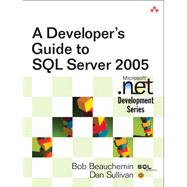Few technologies have been as eagerly anticipated as Microsoft SQL Server 2005. Now, two SQL Server insiders deliver the definitive hands-on guide--accurate, comprehensive, and packed with examples. A Developer's Guide to SQL Server 2005 starts where Microsoft's documentation, white papers, and Web articles leave off, showing developers how to take full advantage of SQL Server 2005's key innovations. It draws on exceptional cooperation from Microsoft's SQL Server developers and the authors' extensive access to SQL Server 2005 since its earliest alpha releases.
You'll find practical explanations of the new SQL Server 2005 data model, built-in .NET hosting, improved programmability, SQL:1999 compliance, and much more. Virtually every key concept is illuminated via sample code that has been fully updated for and tested with the shipping version of the product.
Key coverage includes
- Using SQL Server 2005 as a .NET runtime host: extending the server while enhancing security, reliability, and performance
- Writing procedures, functions, triggers, and types in .NET languages
- Exploiting enhancements to T-SQL for robust error-handling, efficient queries, and improved syntax
- Effectively using the XML data type and XML queries
- Implementing native SQL Server 2005 Web Services
- Writing efficient, robust clients for SQL Server 2005 using ADO.NET, classic ADO, and other APIs
- Taking full advantage of user-defined types (UDTs), query notifications, promotable transactions, and multiple active result sets (MARS)
- Using SQL Management Objects (SMO), SQL Service Broker, and SQL Server Notification Services to build integrated applications








